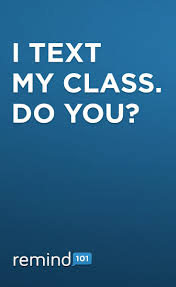Remind 101 – Free Texting App for Educators
I am trying out a new app this summer in my online public health social work course – Remind101. It’s a free and confidential texting service for educators who want to send reminders and other information to students. I heard about it from an episode on NPR’s Marketplace about how venture capitalists in the US are investing in education technology.
During an interview with the company’s CEO, he mentioned one of the motivations for designing the program was to use texting to help kids with disabilities better manage their coursework. This is exactly why I started texting with my students. Several years ago, I had a student in class who had difficulty hearing. The student suggested that we try sending text messages when a translator was not available, and it worked great. Since then, I give students in my courses the option of sending me a text message to communicate with me.
Now, this does mean I have to share my moblie phone number with students. This has not be a problem for me to date, because I provide students with some ground rules and expectations about how and when to text me. Last November, Dr. Nancy Smyth, Dean of the School of Social Work at the University of Buffalo, wrote on her blog about text messaging as an intervention tool for social workers and other healthcare professionals, which prompted me to share my ground rules with her in a comment to her post. Here is what I wrote:
The “ground rules” for the students are simple:
1. The Who: When texting, please Identify who you are and the class. I don’t respond to texts from unidentified persons.
2. The What: Please be professional and brief in the message by using close-ended questions and keeping jargon, acronyms and emoticons to a minimum.
3. The When: During normal business hours, I typically respond to texts within minutes, but it can take longer. I rarely respond to a text between 10 PM and 6 AM.
I provide my cellphone number on the course syllabus and then discuss these ground rules during the first day of class. Frequently, I find that I am often the first professional that students have ever considered sending a text message. This give me a good opportunity to open a discussion with students about professional communication, and we talk about how to pick the best method for the message (i.e. email vs. phone call), communication etiquette, and the importance of good writing, even with texting.
Also, I work to model good professional communication with students throughout the semester, and I have my own set of “ground rules” for texting:
1. I only respond to text messages from students. I never initiate a conversation via texting. If I need to reach a student outside of class, I will email or call as these methods give me more space to explain the reason for my communication.
2. When responding to a student’s text, if my response is too long or complicated to text back, I ask the student to call me or set up an appointment with me. I have not yet found a way to explain how to calculate a standard deviation via texting.
3. I follow all of the ground rules that I set for my students. For example, I sign all of my text messages with my initials and try not to use jargon.
This is what works for me, but I can imagine these “rules” may change in the future as the technology changes.
I did not know about Remind101 back in November, but obviously technology was already ahead of me. Now, I’ll see if I can catch up.
One of Remind101’s features is that the mobile phone numbers of the students and educator are kept confidential. Also, communication is only one-way which provides another layer of privacy. This is a potential disadvantage for me as texting has been a great tool for communicating with students, not just a way to remind them about assignments and posting homework. However, some research about online education with adult learners suggests that course announcements and reminders are highly valued by students taking online courses (Ausburn, 2004). I hope to weigh the pros and cons of Remind101 over the next eight weeks and will share my observations in a later post.
I would be very interested to know how other social work educators are using text messaging with students. Anyone using Remind101 or another similar service? Are there any social work textbooks on professional writing and communication are addressing best practices for texting?
References:
Ausburn, L. J. (2004). Course design elements most valued by adult learners in blended online education environments: an American perspective. Educational Media International, 41(4), 327–337.
Hill, A. (May, 2014). Venture capitalists learn to love education. Retrieved from: http://www.marketplace.org/topics/education/learning-curve/venture-capitalists-learn-love-education
Smyth, N. J. (November, 2013). Intervention with SMS: What’s Next? Retrieved from: http://njsmyth.wordpress.com/2013/11/17/intervention-with-sms-whats-next/
How to cite this post:
Hitchcock, L. I. (2014, June 3). Remind 101 – Free Texting App for Educators[Blog Post]. Retrieved from https://laureliversonhitchcock.org/2014/06/03/remind-101-free-texting-app-for-educators/.



